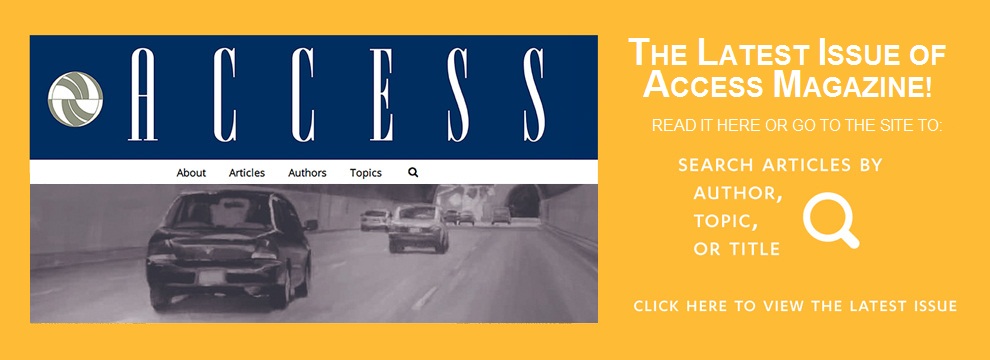Latest Issue Of ACCESS Magazine Now Available!
The Spring/Summer issue of ACCESS magazine is hot off of the press and now available to view at the brand-new ACCESS website, accessmagazine.org. Here’s a taste of what you’ll find in the latest issue:
The Social Context of Travel
Michael J. Smart & Nicholas J. Klein
Imagine two couples living next door to each other in the Castro district of San Francisco. They have similar jobs, interests, and incomes, but one couple is straight while the other is gay. Research now shows that the gay couple’s trips to work, shops, and everywhere in-between are more likely to be local than that of their straight neighbors. But why would this be?
In “The Social Context of Travel,” Michael Smart and Nick Klein explore how the strong social ties of LGBT communities influence travel behavior within the community. This phenomenon brings to light a new element to consider when planning for the transportation needs of a neighborhood.
The First Big-Box Store in Davis
Susan L. Handy, Kristin Lovejoy, Gian-Claudia Sciara, Deborah Salon, and Patricia L. Mokhtarian
Davis, California, has gone to great lengths to avoid sprawl. Multi-family housing is distributed throughout the city, neighborhood shopping centers are within a short bike ride, and the city’s public spaces have been designed to help promote its downtown businesses. So when the Target Corporation proposed opening a store in Davis, many of the residents voiced outrage.
In their article, “The First Big-Box Store in Davis,” Susan Handy, Kristin Lovejoy, Gian-Claudia Sciara, Deborah Salon, and Patricia Mokhtarian research how opening a Target in Davis affected the shopping and travel patterns of the local residents. What did this new box store mean for local businesses? And what could it mean for a city’s goals of sustainability?
Informal Parking: Turning Problems into Solutions
Donald Shoup
Cities employ legions of parking enforcement officers to ensure that drivers obey regulations. But there are several parking markets that go unregulated. Most of the time, it’s harmless enough, even beneficial to the community. But at other times, informal markets can be detrimental to a community.
In his latest article, “Informal Parking: Turning Problems into Solutions,” Donald Shoup discusses a variety of informal parking markets found across the US—from front lawns in Ann Arbor during football games, to doorman-controlled parking in New York City, to parking on sidewalks in Los Angeles. While many of these informal markets are a boon to residents, parking on sidewalks is hazardous to the disabled community and violates the American with Disabilities Act. Shoup recommends that cities implement parking permit districts to control congested curb parking, reopen sidewalks for pedestrians, and generate city revenue.
Suburban Transit in Mexico City
Erick Guerra
Each year, dozens of new transit lines open in cities around the world. Politicians invest in them in order to reduce congestion and sprawl, increase accessibility, and improve their own ratings at the polls. But how effective are they?
Erick Guerra’s article, “Suburban Transit in Mexico City,” follows the effects of expanding metro transit into the densely populated suburb of Ecatepec. While travel times and expenditures for residents were reduced, the affect on congestion, car use, and suburban development might leave developers rethinking their investments.
A Bathtub Model of Downtown Traffic Congestion
Richard Arnott
While sitting in rush hour traffic, many of us wish we could be somewhere else, maybe taking a hot bath in a quiet retreat. But what if we were already sitting in a bathtub…of traffic?
In his article, “A Bathtub Model of Downtown Traffic Congestion,” Richard Arnott demonstrates how the hypothetical Vickrey Bathtub applies to city streets: traffic does flow like water in and out of a bathtub. From his research, he recommends congestion tolling to reduce the frequency and severity of jams, generate revenue, and make commuters better off.
THE ACCESS ALMANAC: Painting in the Present, Imagining the Future
Richard Willson
Here’s an easy question: is transportation research different from landscape painting? Yes, of course, on the surface. But looking at them more closely, we see that they both deal in abstractions, and they both require decisions about what is in and what is excluded. Perhaps they have more in common than we might think.
In his latest article, “Painting in the Present, Imagining the Future,” Richard Willson discusses how transportation painting provides insights that would otherwise be missed in transportation research. He reveals three aesthetics of the freeway experience and the less tangible aspects of freeway driving, such as a desire for mobility and traffic as a dance of vehicles. Such aesthetics also reveal a movement towards a broad range of mobility services that stretch beyond the car.
Can We Have Sustainable Transportation without Making People Drive Less or Give up Suburban Living?
Mark Delucchi and Kenneth S. Kurani
Many of the plans to reduce environmental and financial costs to cities involve ways to reduce the amount of automobiles on the road. But what if we didn’t have to give up our cars?
In their recent paper, “Can We Have Sustainable Transportation without Making People Drive Less or Give up Suburban Living?” Mark Delucchi and Kenneth Kurani advocate for creating a dual-road network, which separates slower and lighter vehicles from faster and heavier vehicles. Such a network could improve road safety and reduce financial and environmental costs, all while allowing people to maintain high levels of automobility.
